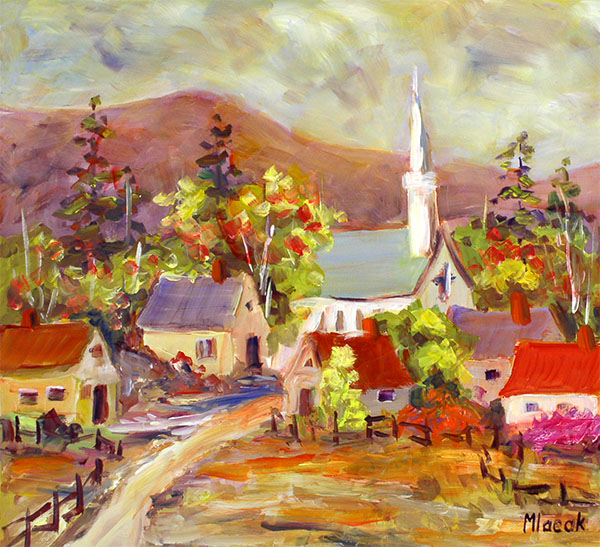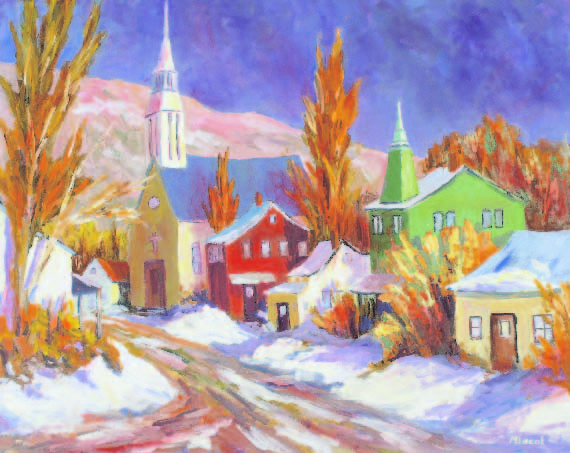Ottawa Citizen
Saturday, November 15, 2008
Breaking News at ottawacitizen.com
Calendar

L'église, Abercorn, oil, 12" x 14", John Mlacak
Painter John Mlacak will be among more than 25 Kanata artists selling original art at the Gift of Art Christmas sale, Nov. 22 and 23.
Also available in PDF format.

Painter John Mlacak’s oil on canvas, titled Rue de l’église, Charlevoix, is just one of 80 juried pieces at the 25th Annual Rideau Valley Art Festival, taking place at the community centre in Westport. The Opening ceremony is 6 p.m. Friday with the show running from 10 a.m. to 6 p.m. Saturday, Aug. 26, and 10 a.m. to 4 p.m Sunday, Aug.27. Admisssion is $5 general, $4 seniors.
Also available in PDF format.
Alex Munter
The Ottawa Citizen
August 20, 2005
Is it the Glebe, the only neighbourhood in recent memory to elect a poet to city council? Or maybe it’s a rural village like

CREDIT: Bruno Schlumberger, The Ottawa Citizen Unlike many Ottawa artists, John Mlacak of Kanata, a retired engineer and politician, is in the lucky position of not having to worry about finances. He has his pension, and his wife, Beth, looks after selling his work. 'I have a unique advantage over other artists. We have two people-years, seven days a week.' Though Ottawa arts incomes are a little higher than the Canadian norm, they're still one-quarter less than the overall labour force average.
Manotick, which has a highly-visible artists’ association? Or could it be a tree-lined suburb like Rothwell Heights or Qualicum, where numerous retirees and stay-at-home parents pursue their vocation? Or how about Vanier, its lower rents and affordable homes perhaps attractive to starving-artist types?
Kelly Hill knows the answer to that question. But he’s not telling. At least not until late September.
That’s the date he’ll be revealing the answer to a national quiz his arts consulting company has launched.
Mr. Hill has crunched the numbers, neighbourhood by neighbourhood, province by province, to see which Canadian postal codes have the greatest concentration of full-time artists or, as he puts it, “people who work at an arts occupation more than any other occupation.”
Peter Honeywell, executive director of the Council for the Arts in Ottawa, is putting his money on the Hintonburg/Westboro area.
He points to the virtual overnight success of Westfest, the spunky, funky, arts festival that has gone from mere idea to community sensation in just two years. “The business community there is getting behind it. They see the benefit of paying artists to come in and do festivals.”
“People visit Westfest one weekend, notice some of the shops that are in the area, don’t have time to go to them, and then go back another week.
“It’s what could happen in every community.”
Mr. Honeywell says the West Wellington area has a critical mass of artists, drawn in part by a broad range of housing types. A popular annual walking tour of artists’ studios is slated for mid-September.
Christine Tremblay predicts that if her part of the city — the suburban east end — doesn’t win the crown yet, it will soon.
“We’re at that point where it’s busting out, everyone wants to go to the next level and that energy is there,” says Ms. Tremblay, who runs Arts Ottawa East.
“We’re encouraging people to take the next step — helping them go a bit more professional.”
Probably nothing illustrates that better than the enthusiasm over the east-end arts facility, which the city plans to open in Orleans in 2008. Arts groups were joined by businesspeople and community leaders in pushing for the project.
Mr. Hill’s contest comes just as the City of Ottawa has released a discussion paper about its arts investment strategy. There is to be extensive consultation about the document this fall.
The discussion paper confirms local artists’ long-standing complaint that Ottawa’s municipal government invests far less in arts and culture than do most Canadian big cities. We come seventh out of seven.
But the document’s most dramatic revelation is actually how poorly we fare in terms of provincial and federal funding, too.
That supposedly nasty right-wing government in Alberta puts seven times as much into Calgary’s and Edmonton’s local arts scenes as the Ontario Arts Council contributes to Ottawa.
Closer to home, Toronto gets three times as much from Queen’s Park as does Ottawa.

CREDIT: Wayne Cuddington, The Ottawa Citizen Dance choreographer Anik Bouvret makes ends meet by working part-time in administration at the National Gallery.
It’s the same story at the federal level. We’re essentially tied for dead last with Calgary, which at least has Ralph Klein looking out for it. Vancouver is the big winner in federal local arts investment.
Add up the support for the arts from all three levels of government and Montreal and Vancouver respectively rake in $46 and $44 per capita. The other cities are in the mid-$20 range.
In Ottawa, dead last, it comes out to $10 per person per year — basically, one cent per day from each level of government.
City statistics show that, for each dollar the City of Ottawa puts into the arts, more than $10 comes from other sources, including fundraising and private investment.
And, there again, we are at the back of the class. That multiplier effect is much bigger elsewhere.
During the city’s last round of extensive consultations on the arts, leading to the 2003 adoption of the arts and heritage plan, American academic Richard Florida made quite a splash when he visited Ottawa.
Mr. Florida, a professor of regional economic development at Pittsburgh’s Carnegie Mellon University, has looked at U.S. cities that are prospering and those that are falling behind.
He says the key to economic success is the presence of a “creative class” that includes scientists and engineers, poets and novelists, artists, entertainers, actors, designers and architects.
Their presence, he argues, is a harbinger of economic success. In this post-industrial era, his research shows that the greater the concentration of such people, the better a city will do economically.
“Creativity has replaced raw materials or natural harbours as the crucial wellspring of economic growth,” he says.
Canadian arts expert Kelly Hill agrees that “the presence of artists and a lively artistic sector builds community cohesion, creates an opportunity to interact and generates economic benefits.”
And he shares Mr. Florida’s conviction: cities that neglect arts and culture won’t just be sadder places to live, they will also hurt their future prospects for prosperity.
Statistics Mr. Hill compiled for the Canada Council for the Arts show that Ottawa has a much lower share of its workforce engaged in the arts than most large Canadian cities and, in fact, is rivalled by many smaller centres.
Places like St. John’s, Halifax and Victoria have, proportionately, many more artists. Ottawa is comparable to Winnipeg and Kingston, but even that stat is misleading. Those cities don’t have major federal arts institutions like the National Arts Centre bumping up the number.
The problem is, local artists generally don’t have access to those venues. They don’t belong to Ottawa the town, they belong to Ottawa the capital.
After all, if you’re a local artist, you can’t wander over to the National Gallery and hang your work there.
Mr. Hill says your mother was right when she warned you there wasn’t much money in the arts. Though Ottawa arts incomes are a little higher than the Canadian norm, they’re still one-quarter less than the overall labour force average.
And that means many artists, like contemporary dance choreographer Anik Bouvret, get other jobs to make ends meet.
“Being an artist is very difficult financially. At 36 years old, I’m hopeful at some point I’ll be able to do it full-time, but I’m also realistic. It hasn’t happened so far.”
But Ms. Bouvret, who grew up in Orleans and returned there after completing a dance degree in British Columbia, considers herself lucky to have found part-time employment at the National Gallery.
“At least my administrative job is quite inspiring because I am in an artistic environment.”
Ms. Bouvret mostly practices her craft downtown at venues like La Nouvelle Scene or at dance festivals in other cities. But she too has noticed the burgeoning arts scene in the east end.
“A window has opened,” she says. “Now is the time to bring the arts into the community.”
Peter Honeywell, of the Council for the Arts, says Ottawa’s lack of venues for performing arts has chased many of the city’s best and brightest away.
Our strength has tended to be in sectors where artists can work independently out of their homes, like writing or the visual arts, he says.
He’s talking about people like John Mlacak of Kanata.
An engineer by training, Mr. Mlacak originally got into art for therapeutic reasons. “After my heart attack in 1978, I took an art class and I found I enjoyed it.”
“It took me about five years to find out there aren’t any rules to art,” he said.
“I discovered the difference between an artist and an engineer. If you give a problem to 100 engineers, you’ll get one answer and it’ll be right. If you give a problem to 100 artists, you’ll get a hundred different answers and they’ll all be right.”
After his retirement in 1994, Mr. Mlacak delved into art full-time. He now spends five hours a day painting, mainly in oils but occasionally in watercolours and pastels. His paintings, generally landscapes, are widely exhibited locally. He sells about 50 per year.
Mr. Mlacak, 69, says his third career bears a lot of similarities to his first two jobs, in engineering and local politics. “It’s all been design work. I haven’t fundamentally changed what my nature is.”
Mr. Mlacak admits his pension gives him the freedom to pursue his art full-time. He attributes much of his success to his wife, Beth, who handles the marketing and promotion of his work. “I have a unique advantage over other artists.
“We have two people-years, seven days a week.”
As more and more energetic, educated baby boomers are liberated from their careers, one wonders how many will follow Mr. Mlacak’s example and unleash the artist within.
Who knows?
Maybe Ottawa’s most creative neighbourhoods will become the ones with the highest concentration of young seniors.
But, for now, Mr. Hill drops a small hint about the kind of postal codes that will make his top-10 list: “they’ll be funky neighbourhoods that a lot of people are drawn to.”
To enter the contest, go to www.hillstrategies.com.
And just a note to my regular readers — I am still researching the subject originally slated for today’s ‘Neighbourhood Faces’ column, divisions within rural Ottawa. That piece has been delayed to the fall, closer to the date of the rural summit.
Alex Munter is a visiting professor at the University of Ottawa and former Ottawa city councilor. E-mail him at amunter@uottawa.ca.
Next Week: A visit to Ottawa’s emerging gaybourhood.
© The Ottawa Citizen 2005
Also available in PDF format.